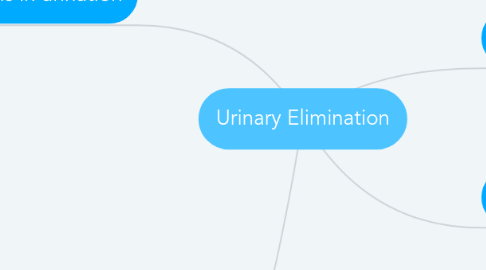
1. Alterations in urination
1.1. Polyuria
1.1.1. production of large amounts of urine by the kidney
1.1.1.1. how?
1.1.1.1.1. diabetes mellitus
1.1.1.1.2. diabetes insipidus
1.1.1.1.3. kidney dieases
1.2. Polydipsia
1.2.1. extreme thirst, which lead to compulsive intake of excessive amounts of fluid
1.2.1.1. leads to...
1.2.1.1.1. dehydration
1.2.1.1.2. weight loss
1.2.1.1.3. intense THRIST
1.3. Anuria
1.3.1. absence of urine production
1.4. Oliguria
1.4.1. production of small amounts of urine by the kidney
1.4.1.1. leads to...
1.4.1.1.1. fluid loss
1.4.1.1.2. impaired blood flow to the kidneys
1.4.1.1.3. impeding renal failure
1.5. Nocturia
1.5.1. voiding at night
1.5.2. increase in fluid intake
1.5.3. UTI
1.6. Urgency
1.6.1. sudden strong desire to void
1.6.2. common in those who have poor external sphincter control and unstable bladder contractions
1.7. Dysuria
1.7.1. voiding that is painful
1.7.2. UTI
1.8. Incontinence
1.8.1. loss of bladder control
1.8.2. leakage when coughing, laughing, sneezing
2. Factors affecting Urinary Elimination
2.1. fluid and food intake
2.1.1. alcohol
2.1.1.1. frequency of voiding
2.1.2. high in sodium
2.1.2.1. fluid retention
2.1.3. beets (carotene)
2.1.3.1. color of urine
2.2. muscle tone
2.2.1. detrusor muscle
2.2.1.1. helps bladder fill and empty completely
2.3. psychosocial factors
2.3.1. anxiety and muscle prevention
2.3.1.1. causes pt not to relax, which causes not voiding
2.4. pathological conditions
2.4.1. renal faliure
2.4.1.1. causes the kidneys cease to produce urine
2.5. Surgical and Diagnostic Prodedures
2.5.1. cystoscopy
2.5.1.1. cause swelling of urethra
2.6. Medications
2.6.1. diuretics
2.6.1.1. increase urine formation (peeing a lot)
3. WHAT is it?
3.1. controls blood volume and composition
3.2. rids the body of excess fluid and electrolytes
4. WHERE is it?
4.1. Upper urinary tract
4.1.1. kidneys
4.1.2. ureters
4.2. lower urinary tract
4.2.1. urinary bladder
4.2.2. urethra
4.2.3. pelvic floor
